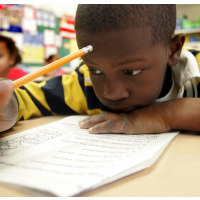Low-Income Students Now a Majority in Public Schools in 17 States
 (photo: Jose F. Moreno, AP)
(photo: Jose F. Moreno, AP)
Public schools are becoming underfunded dumping grounds for the nation’s poor students, and a new report says that for the first time in nearly 50 years “a majority of public school children in 17 states … were low income students” at the close of 2011 school year. Thirteen of the 17 states are in the South, and the remaining four (New Mexico, California, Oregon and Nevada) are in the West. Just ten years ago, only four states had such majorities, says the report released by the nonprofit Southern Education Foundation (SEF).
The trend is especially pronounced in the South, where only Virginia did not fall on the list. The states with the worst rates are Mississippi (71%), New Mexico (68%), Louisiana (66%), Oklahoma (60%), and Arkansas (60%), which are the only states with rates of at least 60%. Only three states—New Jersey, North Dakota and New Hampshire—had rates below one-third.
Although the number and percentage of low-income students attending public schools has been rising since at least 1989, between 2001 and 2011 the numbers soared 32% – a jump of more than 5.7 million children that raised the nationwide share from 38% to 48%. The report blames high unemployment, growth of low-wage jobs, immigration, and a falling middle-class birthrate.
Despite the growing share of poor students—or perhaps because of it—spending on public education has failed to keep pace, increasing by only 14% in the last decade. Even worse, the report found that schools with the highest shares of poor children spent the least on educating them, and that the fad for handing tax dollars to private schools in the form of tuition vouchers is unlikely to improve educational outcomes for poor kids because “the learning gap for low income students has generally been as large or larger in private schools as in public schools across the nation.”
SEF vice-president Steve Suitts, who wrote the report, emphasized the long-term dangers the data present: “With huge stubborn unchanging gaps in learning, schools in the south and across the nation face the real danger of becoming entrenched, inadequately funded educational systems that enlarge the division in America between the haves and the have-nots and endanger the entire nation’s prospects.”
Richard Coley of Educational Testing Service, who wrote a report (pdf) released in July showing that the U.S. has the second-worst child poverty rate among the world’s 35 richest nations, agreed with Suitt: “If we don’t wake up in this country and deal with it we are going to pay the price. The problem is that the skills that these kids need are getting more complex. It’s going to make the US less competitive.”
- Matt Bewig
To Learn More:
A New Majority: Low Income Students in the South and Nation (by Steve Suitts, Southern Education Foundation)
Study sounds alarm over%age of low-income students in public schools (by Karen McVeigh, The Guardian)
Balance of Financial Aid from Public Universities Tilts Away from Low-Income Students (by Noel Brinkerhoff, AllGov)
Good Students from Low-Income Families Less Likely to go to Top Colleges (by Matt Bewig, AllGov)
- Top Stories
- Unusual News
- Where is the Money Going?
- Controversies
- U.S. and the World
- Appointments and Resignations
- Latest News
- Trump to Stop Deportations If…
- Trump Denounces World Series
- What If China Invaded the United States?
- Donald Trump Has a Mental Health Problem and It Has a Name
- Trump Goes on Renaming Frenzy






Comments